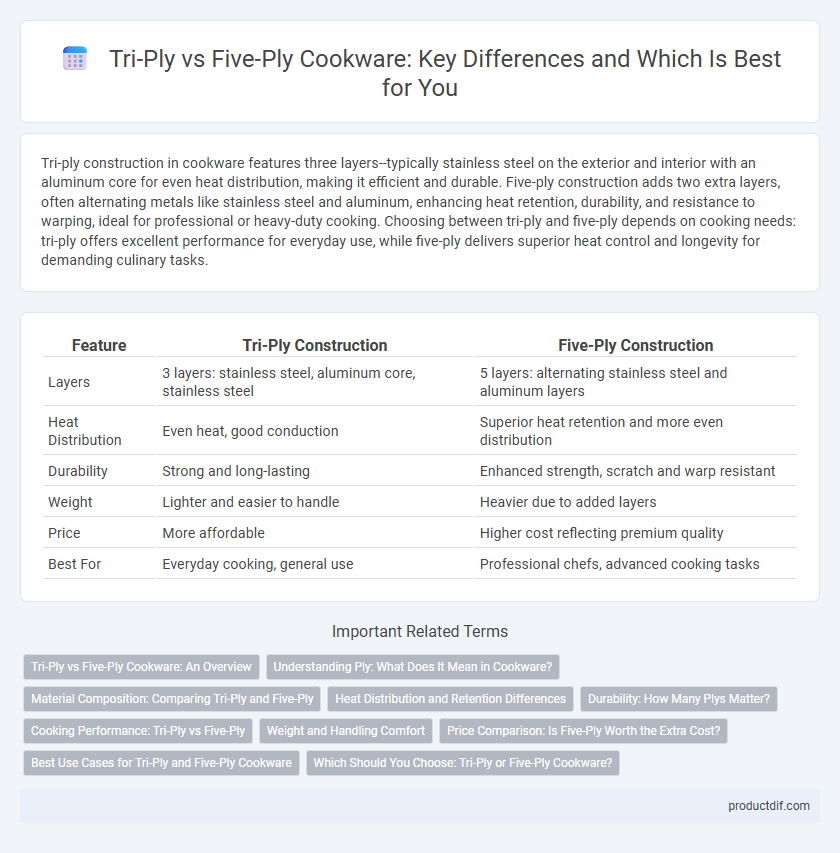Tri-ply construction in cookware features three layers--typically stainless steel on the exterior and interior with an aluminum core for even heat distribution, making it efficient and durable. Five-ply construction adds two extra layers, often alternating metals like stainless steel and aluminum, enhancing heat retention, durability, and resistance to warping, ideal for professional or heavy-duty cooking. Choosing between tri-ply and five-ply depends on cooking needs: tri-ply offers excellent performance for everyday use, while five-ply delivers superior heat control and longevity for demanding culinary tasks.
Table of Comparison
| Feature | Tri-Ply Construction | Five-Ply Construction |
|---|---|---|
| Layers | 3 layers: stainless steel, aluminum core, stainless steel | 5 layers: alternating stainless steel and aluminum layers |
| Heat Distribution | Even heat, good conduction | Superior heat retention and more even distribution |
| Durability | Strong and long-lasting | Enhanced strength, scratch and warp resistant |
| Weight | Lighter and easier to handle | Heavier due to added layers |
| Price | More affordable | Higher cost reflecting premium quality |
| Best For | Everyday cooking, general use | Professional chefs, advanced cooking tasks |
Tri-Ply vs Five-Ply Cookware: An Overview
Tri-ply cookware features three layers combining stainless steel and aluminum, offering balanced heat distribution and durability ideal for everyday cooking. Five-ply construction incorporates additional layers, often alternating stainless steel and aluminum, enhancing heat retention and preventing warping for professional-grade performance. Choosing between tri-ply and five-ply depends on desired heat conductivity, cookware weight, and long-term investment in kitchen tools.
Understanding Ply: What Does It Mean in Cookware?
Tri-ply construction in cookware consists of three bonded layers, typically combining stainless steel with an aluminum core to ensure even heat distribution and durability. Five-ply construction adds two more alternating layers, enhancing thermal conductivity and resistance to warping for superior cooking performance. Understanding ply means recognizing how these layers impact heat retention, cooking efficiency, and overall cookware longevity.
Material Composition: Comparing Tri-Ply and Five-Ply
Tri-Ply cookware typically consists of three layers: stainless steel, an aluminum core for even heat distribution, and another layer of stainless steel for durability. Five-Ply construction enhances heat retention and distribution by adding two more alternating layers of aluminum and stainless steel, often resulting in better thermal responsiveness. The increased layering in Five-Ply cookware provides superior strength and prevents warping compared to Tri-Ply, making it ideal for professional chefs and serious home cooks.
Heat Distribution and Retention Differences
Tri-ply construction features three layers, typically combining an aluminum core between stainless steel, providing fast and even heat distribution suitable for most cooking tasks. Five-ply construction incorporates additional layers of aluminum or stainless steel, enhancing heat retention and minimizing hotspots for precise temperature control in complex cooking. The increased layering in five-ply cookware improves thermal stability, making it ideal for recipes requiring consistent, long-duration heat.
Durability: How Many Plys Matter?
Five-ply cookware offers superior durability compared to tri-ply construction due to its additional layers of metal, enhancing resistance to warping and corrosion. The extra layers in five-ply pans improve heat distribution, resulting in consistent cooking performance and longer lifespan. Investing in five-ply cookware ensures a robust kitchen tool that withstands heavy use and maintains structural integrity over time.
Cooking Performance: Tri-Ply vs Five-Ply
Five-ply cookware offers superior heat distribution and retention compared to tri-ply construction, delivering more even cooking results and minimizing hot spots. The additional layers in five-ply pans enhance durability and thermal efficiency, making them ideal for precise temperature control and fast heat responsiveness. While tri-ply cookware provides reliable performance with consistent heat conduction, five-ply models outperform in professional and high-demand cooking environments.
Weight and Handling Comfort
Tri-ply construction cookware typically offers lighter weight and better handling comfort due to its three-layer design, enhancing maneuverability during cooking. Five-ply construction, with its additional layers, provides superior heat distribution but results in heavier cookware, which may reduce ease of handling for extended use. Choosing between tri-ply and five-ply depends on prioritizing either lightweight convenience or enhanced thermal performance.
Price Comparison: Is Five-Ply Worth the Extra Cost?
Five-ply cookware typically costs 30-50% more than tri-ply due to its additional layers of metal, which enhance heat distribution and durability. While five-ply offers better heat retention and resistance to warping, tri-ply provides sufficient performance for everyday cooking at a more affordable price point. Choosing five-ply is worthwhile for professional chefs or serious cooks who prioritize longevity and precise temperature control, but casual users may find tri-ply to be a cost-effective option without significant compromise.
Best Use Cases for Tri-Ply and Five-Ply Cookware
Tri-ply cookware, featuring a three-layer design with an aluminum core sandwiched between stainless steel, offers excellent heat conductivity and durability ideal for everyday cooking and recipes requiring even heat distribution. Five-ply cookware, with additional alternating layers of stainless steel and aluminum, provides superior heat retention and uniformity, making it perfect for professional chefs and high-precision cooking methods like searing and slow simmering. Choosing tri-ply is best for versatile home use and moderate heat control, while five-ply excels in intensive culinary tasks demanding consistent temperature stability and enhanced cookware longevity.
Which Should You Choose: Tri-Ply or Five-Ply Cookware?
Tri-ply cookware features three bonded layers, typically stainless steel with an aluminum core, providing excellent heat conductivity and even cooking, ideal for everyday use and moderate heat retention. Five-ply construction incorporates additional layers, often alternating stainless steel and aluminum, enhancing durability, heat distribution, and resistance to warping, making it suitable for high-performance cooking and longevity. Choosing between tri-ply and five-ply depends on cooking frequency, heat precision needs, and budget, with five-ply offering superior performance at a higher price point and tri-ply balancing efficiency with affordability.
Tri-Ply Construction vs Five-Ply Construction Infographic

 productdif.com
productdif.com